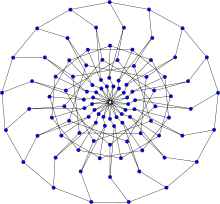This article includes a list of references, related reading, or external links, but its sources remain unclear because it lacks inline citations. (September 2021) |

In the mathematical field of graph theory, a distance-transitive graph is a graph such that, given any two vertices v and w at any distance i, and any other two vertices x and y at the same distance, there is an automorphism of the graph that carries v to x and w to y. Distance-transitive graphs were first defined in 1971 by Norman L. Biggs and D. H. Smith.
A distance-transitive graph is interesting partly because it has a large automorphism group. Some interesting finite groups are the automorphism groups of distance-transitive graphs, especially of those whose diameter is 2.